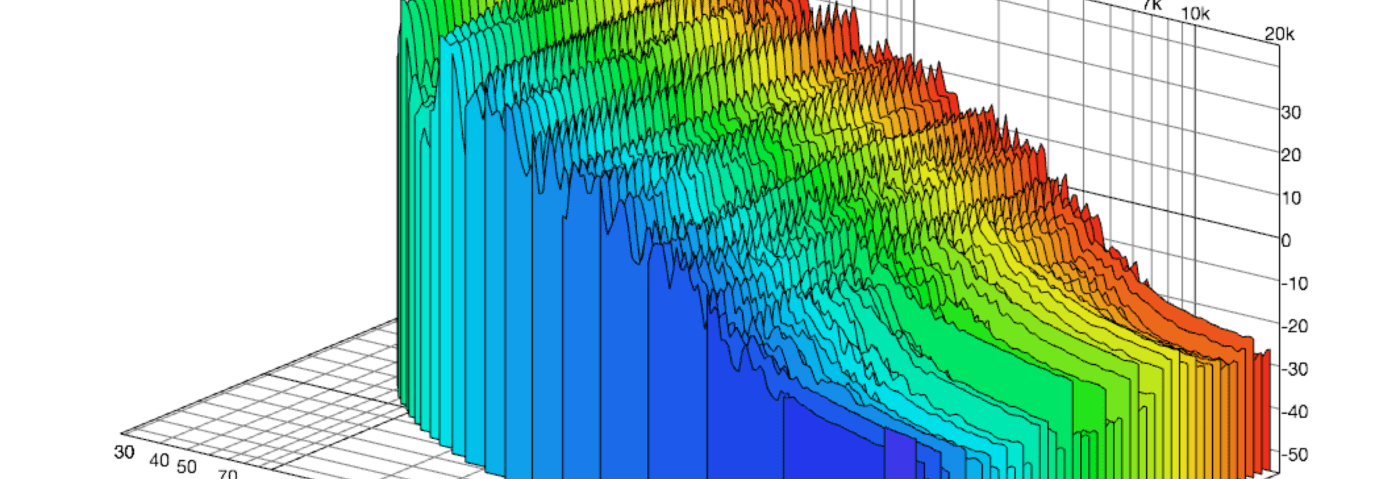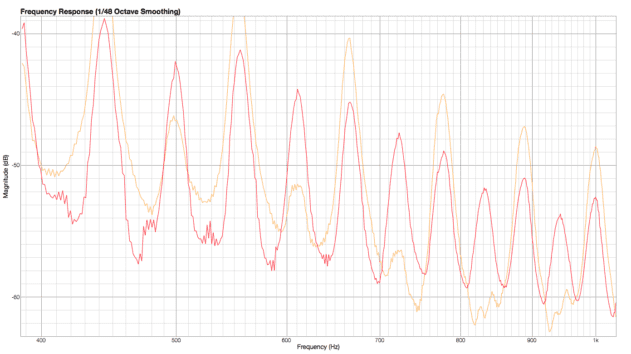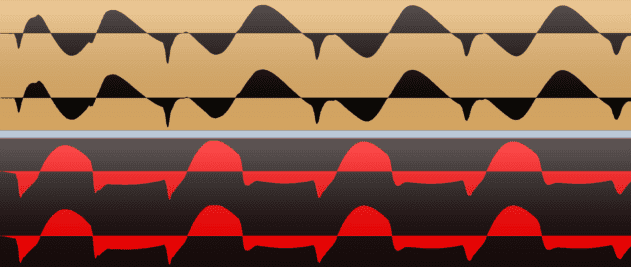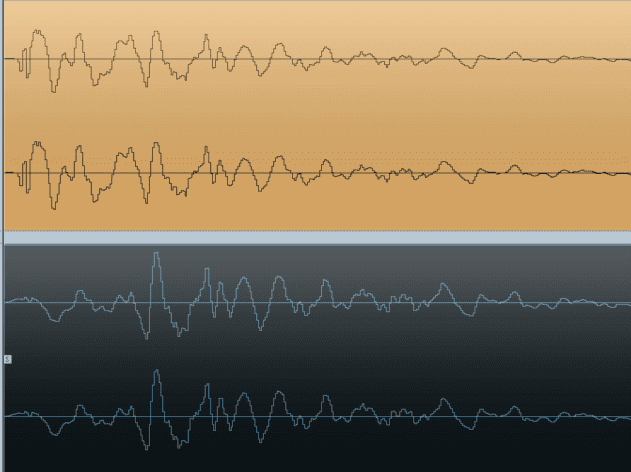Getting Dirty
So far, this all assumes we’re using a medium that has a broadly similar performance across quiet and loud sound sources. In fact, most analogue recording gear has a much smaller ‘linear’ range when compared to modern 24-bit DAWs.
Tape in particular exhibits frequency-dependent compression, which becomes more and more significant at higher signal levels. This delivers the much-loved sound of tape saturation, and a progressive form of audio ‘squashing’ that is associated with ‘warmth’.
A good way to see this in hear this in action is by taking a bass sound…
…and comparing it with two different tape versions…
The first is a ‘normal’ recording, while the second is recorded ‘hot’ (i.e. with the signal pushed to higher levels on the input), and therefore creating enhanced saturation.
The frequency response chart clearly shows a more complex curve for the hot tape version (orange) in the 400-1000 Hz range when compared to the original (red):
However, this doesn’t provide the full picture. Comparing the two in a waveform editor shows that the waveform undergoes quite a bit of transformation in the process:
Capturing The Moment
Pushing the incoming signal level is most definitely where much of the excitement lies, but there is a possible downside to saturation. Squashing a signal dynamically can mean losing some transient detail.
This is especially important when it comes to drum sounds.
Here we have a layered snare and clap hit. Comparing the attack portion of the waveform of each helps us see what is going on. The original is shown by the black wave on a tan background, while the tape version is the blue line on grey background:
Whilst some transient detail can be lost, here (and especially in parts of an analogue signal chain utilising valves or transformers) harmonically pleasing distortions may make for a more favourable, if less ‘accurate’, overall sound.
We looked at harnessing some of these techniques in software in the Adding Analogue and Creative Distortion walkthroughs.




12.31 PM
Superbe Tipps!
I also Like the Studer A800 Plugin by UAD. I ll try this : Routing all Hi Hats to one Bus and insert the Studer Plugin =)
03.10 PM
Great article- I have been experimenting with Recording tracks to my Old TEAC Reel to Reel 1/2″ Tape . IMHO I’t’s a good halfway point between Cassete and a Pro Tape machine like a Studer. Probably cheaper to get a Plugin but decent old Reel to Reels can be had for little as 300.00 or les if you look hard.
02.27 AM
the bass a80 hot is played one octave below both other examples….
WHY?
10.00 AM
Same samples are also louder than others :/
02.07 PM
With this compendium, a good software developer could easily create the ultimate allround analogue plugin that contains all these characteristics in ONE PLUGIN – rather than having a seperate tape plugin, an analogue compressor plugin, a vintage preamp plugin etcetera
10.38 AM
Great article…
I’m not sure that the A80 Hot is an octave lower Johannes?
Also re: Paschalis comment – loudness will be altered by the saturation (and compression effect) of the processing – tape etc.
09.11 PM
That graph of ‘white noise’ looks more like Pink Noise since it’s a logarithmic scale and seems to show equal energy per octave. On a log scale, White noise will rise by 3dB per octave.
11.40 AM
If my analogue mixer had a response like the one on page 4, I’d throw it in the trash.
01.04 AM
being a virgin to audio on both forms of sound whether it be digital or analogue and on the cusp or transition to digital I’m definitely open to understanding both. I understand that sound is analogue to begin with but then needs to be recorded. Is it to my understanding that vinyl and tape are analogue. or are they turned to another format before made into tape or vinyl first. This is my quandary. if it is surely you’ll loose something from the recording or if this isn’t the case then analogue to analogue to analogue you lose nothing but add something like noise… etc